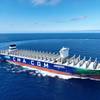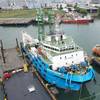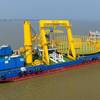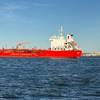Great Ship: Great Ships of 2003
Great Ship: MSC Linzie
Ship Owner Mediterranean Shipping Co. S.A.
Ship Builder Hanjin Heavy Industries & Construction
Ship Type Containership
MSC Linzie is the first vessel of a new vessel type developed and designed by Hanjin which adopts the new Panamax length design of 294.05 m. Apparently the design series and Hanjin's well-established reputation in this niche has proved attractive, as the company has, to date, logged orders for 24 ships of the new design.
As mentioned above, its length is the maximum for Panama canal, i.e. 294 m. So it has been designed to move flexibly both in Pacific Ocean and in Atlantic Ocean through Panama canal, which is one of the main feature that makes it popular among the operator.
This ship offers the maximum intake of 5,060TEU. It is composed of six holds and each hold is capable of holding two stacks of hi-cube containers and also equipped with cell guides exclusively for 40 ft. containers together with fittings for the 20 ft. container, which enhances loading flexibility in hold. On deck it is even more flexible due to the loading ability of 20/40/45ft containers including separate loading facility for special cargos like dangerous cargos and 400 refrigerated FEU.
The accommodation is equipped with convenient facilities for a total of 35 person including accommodation for six Suez-canal crews
Recent sea trial result has shown that it has been so comfortably designed for the crews inside that the vibration and noise level has been noticeably reduced.
HSD-built MAN B&W 9K90MC-C has been mounted and its trial speed is 23.06knots when operating at 15% sea margin (90% MCR) at the scantling draft of 13.5m.
The supply material and accessory features are arranged based on an environmentally friendly design. The major machineries and electronic parts are the ones whose performance has been verified through plenty of testing periods for the easy operations and also has been selected among the makers familiar to the operators.
Great Ship: OOCL Shenzhen
Builder Samsung Heavy Industries Co., Ltd.
Owner Orient Overseas Container Lines
Type Containership
Samsung has constantly contributed with suitable technologies in the ever increasing size of containership. Ten 8,063 TEU designs for Orient Overseas Container Lines are the largest liners built and delivered by the Geoje shipyard till now. The first two are now being put into service. This comprises a short accommodation block and engine room positioned approximately three-quarters aft, and eight holds forward and one aft of this position, providing 15 FEU bays in way of holds 1 to 8, with 4 FEU bays over No. 9 hold. The forward holds are dimensioned to carry 1 x 40 ft. containers in cell-guides of No.1 hold, 2 x 40 ft. containers in cell-guides of holds 2 to 8 with four transverse panels. The aft hold with five sets of covers for No.9 F hold and otherwise four sets of covers can carry 3 x 40 ft. bays. 45ft container can be loaded directly on hatch covers every other bay form No.3 hold to No. 9 hold.
Container capacity in the holds is 3,715 TEU, with either 4,144, or 4,348 TEU carried on deck, depending on whether stacks are seven or eight tiers high. Maximum stowage on deck is 17 rows of eight tiers high, and in the holds 15 rows and nine tiers. Lashing bridges are fitted on deck between the hatches, and on deck cell guide are fitted on mooring deck. A total of 710 FEU self-contained air-cooled type reefer containers shall be loaded 510 FEU on deck and 200 FEU in hold. Dangerous goods can be loaded in holds 1 to 8 and on deck.
The hatch coamings are continuous and form the major longitudinal strength member, and a double hull surrounds the cargo space to form part of a tank arrangement comprising side, bilge, and three transverse double-bottom compartments. Two side tanks, port and starboard, are used for automatic heel adjustment, with water ballast transferred by means of a heeling pump.
OOCL Shenzhen claims to be fitted with the largest-sized main engine currently available for marine use: a MAN B&W 12K98MC-C unit built in Korea by HSD, with an MCR rating of 93,120 BHP (68,520kW) at 104 rev/min. When operating at 85% full power but without the shaft generator operating, the vessel has a service speed of 25.0 knots. Electric supply is from a 3,000 kW Taiyo shaft-driven alternator, supplemented by four Daihatsu/Taiyo 3,000 kW diesel-driven sets in an arrangement controlled by a power management system. One Nakashima 2,500 kW bow thruster and one SR63m-type of Rudder are fitted for efficient manoeuvring. Propulsion is by means of a six-bladed FP propeller.
IZAR Delivers LNG Inigo Tapias
IZAR Sestao Shipyard has delivered the LNG, Inigo Tapias, which will be operated by the company F. Tapias for Repsol YPF-Gas Natural.
After conclusion of tests, carried out by the shipyard in the Gas Natural facilities in Huelva and valued by the shipowner, the ship was delivered completely operative and was delivered a month ahead of schedule. During the tests, the cargo has reach quantity of 5,000 cu. m. of gas.
The Inigo Tapias has the capacity to transport 138,000 m3 of liquefied natural gas at 163 degrees C below 0, in four tanks with a double membrane type No96 as a system of isolation and contention of cargo.
Inigo Tapias is the first LNG of this dimension built in Spain and the first of a series of five that IZAR has under construction for Repsol YPF, Gas Natural and Unión Fenosa. IZAR is the only shipyard in Europe and among the few in the world, capable of the construction of this type of ship -high technology and added value- and has achieved a strong position in this sector.
Diesel Engines Factory in Manises provided five deck cranes, three hose handling cranes type GPH 500-1224 and two service cranes type GPS 320-1218.
Great Ship: Methane Princess
Builder Daewoo Shipbuilding & Marine Engineering Co.Ltd
Owner Golar LNG Ltd.
Type LNG Carrier
Methane Princess is a 138,000 cu. m. Liquefied Natural Gas (LNG) Carrier ordered by Golar LNG Ltd. and delivered by Daewoo Shipbuilding & Marine Engineering Co. Ltd. Designed for the world-wide transportation of LNG, the U.K. registered and flagged vessel was delivered August 25, 2003. The vessel is designed and constructed to meet the requirement of Det Norske Veritas (DNV) with the class notation +1A1, Tanker for Liquefied Gas, Ship type 2G (0.25 bar, -163 oC, 500kg/m3), NAUTICUS (Newbuilding), E0, W1-OC, LCS (SID). Methane Princess has a continuous upper-deck with aft sunken deck, a raked stem with bulbous bow, a bow thruster, a semi-balanced rudder and fixed pitch propeller driven by marine steam turbine. Four (4) cargo tanks totaling 138,000 cu. m. capacity are designed as GTT membrane type ("GT No 96 E-2 system") and will keep the LNG at -163 oC, under the condition of maximum daily boil-off rate less than 0.15% of fully loaded cargo volume. Primary/secondary barriers of 36% nickel-steel alloy (Invar, 0.7mm thickness) which have a low thermal expansion coefficient are installed in cargo tanks and plywood boxes filled with expanded perlite are used for the primary/secondary insulation.
Through the cargo hold length, underdeck passageways are arranged port and starboard in trunk deck space and also center passageway (pipe duct) with trolley system is arranged in the double bottom. These passages are used as pipe & cable passages and for inspection/maintenance.
Fatigue design of hull structure is based on the life time of 40 years in North Atlantic sea conditions.
A six (6) tier deckhouse located aft provided accommodation for 40 persons including Suez crews and the vibration levels in living areas are designed especially low at normal operating condition.
Cargo handling systems are designed to be capable of loading or discharging the LNG within 12 hours using eight cargo pumps with capacity of 1,700 cu. m./hr. and four (4) stripping/spray pumps.
Liquefied cargo handling equipments such as two (2) sets of main cargo pumps, one set of spray/stripping pump, one set of capacitance type level gauge including back-up capacitance type top/bottom sensor and one set of float type level gauge are fitted in tripod mast construction which forms a complete assembly unit per cargo tank by incorporating all outfittings and piping in cargo tanks. Vapor cargo handling equipments such as two high duty compressors, two low duty compressors, one main vaporizer, one forcing vaporizer and two boil-off/warm-up heater are arranged in cargo machinery room which is effectively arranged so as to be readily accessible, easy operation and maintenance.
This vessel is designed to meet ship/shore compatibility of the LNG loading/unloading terminals Everett, Elba Island, Cove Point, Lake Charles in USA, Point Fortin in Trinidad, Das Island in UAE, Ras Laffan in Qatar, Qalhat in Oman, Dabhol in india, Huelva, Cartagena, Barcelona and Bilbao in Spain, EcoElectrica in Puerto Rico and also LNG discharge terminals in Korea. Mooring arrangement, fender contact flat area, gangway landing position/support, manifold arrangement and ship/shore communication systems for the above all LNG terminals are considered sufficiently in this vessel. Air draft limitation for Tobin bridge in Boston is successfully satisfied by applying the folding type antenna mast. The main powering unit consist of the Kawasaki UA-360 (MCR: 36,000 ps x 88 rpm) Cross compound steam turbine with high pressure turbine and low pressure turbine, double reduction gear, main condenser including astern turbine. Two (2) sets of dual fuel burning main boilers supply the steam for the main turbine, turbo generator, main feed water pump and other steam driven machinery are designed to be capable of burning of heavy fuel oil and also gas fuel by the low duty compressor through boil-off/warm-up heater for the use of boil-off gas.
The ship's Integrated Automation System (IAS) has been designed, programmed and installed by Korea Honeywell, using the Total Plant Solution (TPS) system with redundant data highway (LCN).
IAS dedicates the data acquisition for centralized process monitoring, incremental levels of distributed digital controls, history and alarm collection, reporting, communication with other process subsystems, open system provisions, control of extension alarm system and integration of extension VDU system for process/alarm monitoring.
The bridge is designed for optimum operational safety, efficiency, takes advantages of current technology and rational navigational methods. For the bridge operation under normal conditions by one person, the system comprises a modular workstation arrangement, meeting all design and equipment layout requirements in accordance with DNV notation W1-OC.
Great Ship: MV Midnight Sun
Builder NASSCO
Owner Totem Ocean Trailer Express
Type Trailership
Early this year National Steel and Shipbuilding Company (NASSCO), a wholly owned subsidiary of General Dynamics, delivered the M.V. Midnight Sun to Totem Ocean Trailer Express, Inc. (TOTE). The Midnight Sun is significant as it was the first commercial dry cargo vessel to be built in the U.S. in 10 years, and the first of two new Orca-class trailerships being built by NASSCO for TOTE's service from Tacoma, Wash., to Anchorage, Alaska. The M.V. Midnight Sun is a 840-ft. long, 118-ft. wide (256 x 35.9-m) RoRo cargo ships capable of carrying highway trailers as large as 53 ft. (16.1 m) in length. Cargo decks are 360,000 sq. ft. and able to carry up to 600 cargo trailers and 220 autos as well as oversized freight. The ship employs twin-screw, diesel-electric propulsion that can achieve a speed of more than 24 knots. The ships' cargo can be loaded and discharged in nine hours, with the speed and efficiency of cargo handling being an important competitive advantage for TOTE. M.V. Midnight Sun and its sister ship M.V. North Star have received several prestigious awards for their environmentally sensitive features. These awards include the States/British Columbia Oil Spill Task Force Legacy Award for 2000, the Alaska Department of Environmental Conservation Commissioner's 2000 Pollution Prevention Award, and the U.S. Coast Guard's William M. Benkert Foundation 2002 Environmental Excellence Bronze Award.














